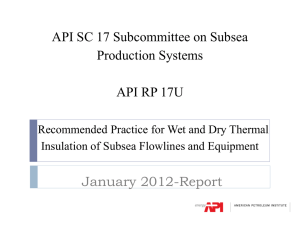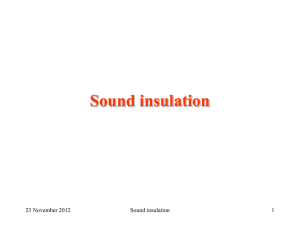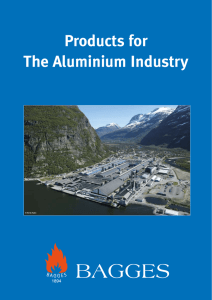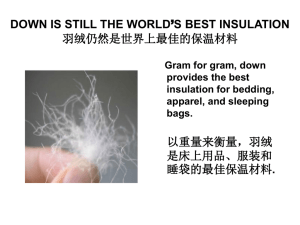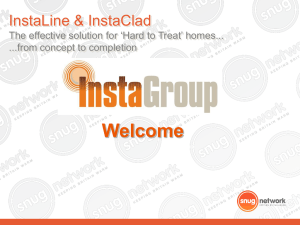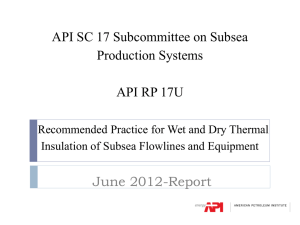GreenFiber™ Cellulose Insulation C.S.I. 3
advertisement
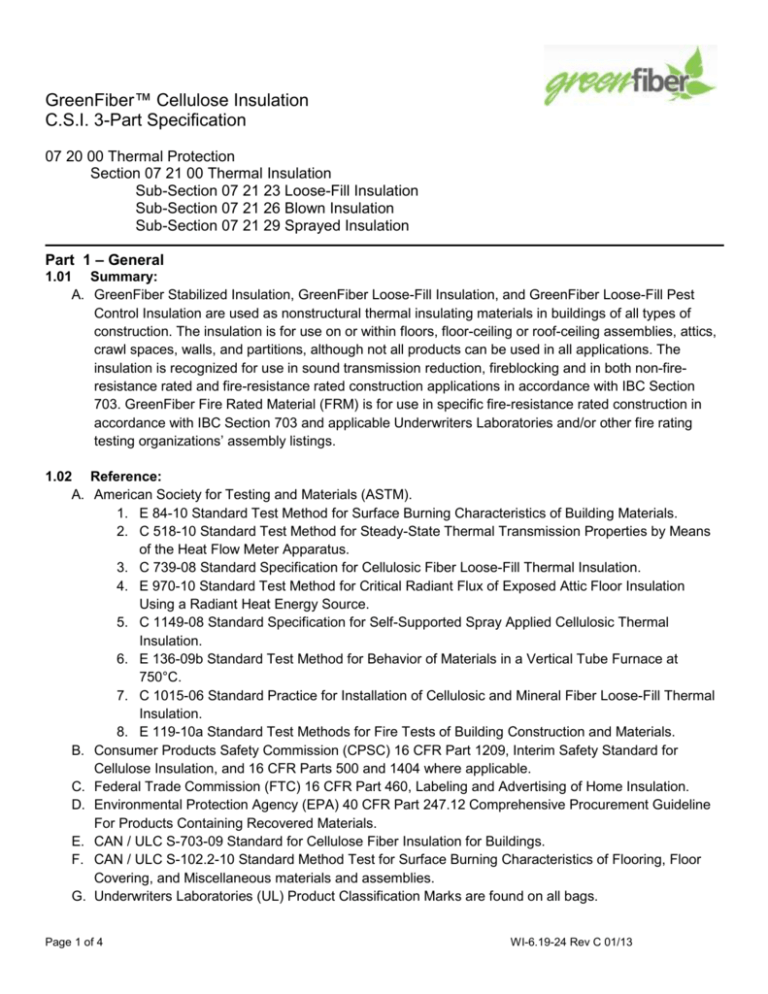
GreenFiber™ Cellulose Insulation C.S.I. 3-Part Specification 07 20 00 Thermal Protection Section 07 21 00 Thermal Insulation Sub-Section 07 21 23 Loose-Fill Insulation Sub-Section 07 21 26 Blown Insulation Sub-Section 07 21 29 Sprayed Insulation Part 1 – General 1.01 Summary: A. GreenFiber Stabilized Insulation, GreenFiber Loose-Fill Insulation, and GreenFiber Loose-Fill Pest Control Insulation are used as nonstructural thermal insulating materials in buildings of all types of construction. The insulation is for use on or within floors, floor-ceiling or roof-ceiling assemblies, attics, crawl spaces, walls, and partitions, although not all products can be used in all applications. The insulation is recognized for use in sound transmission reduction, fireblocking and in both non-fireresistance rated and fire-resistance rated construction applications in accordance with IBC Section 703. GreenFiber Fire Rated Material (FRM) is for use in specific fire-resistance rated construction in accordance with IBC Section 703 and applicable Underwriters Laboratories and/or other fire rating testing organizations’ assembly listings. 1.02 Reference: A. American Society for Testing and Materials (ASTM). 1. E 84-10 Standard Test Method for Surface Burning Characteristics of Building Materials. 2. C 518-10 Standard Test Method for Steady-State Thermal Transmission Properties by Means of the Heat Flow Meter Apparatus. 3. C 739-08 Standard Specification for Cellulosic Fiber Loose-Fill Thermal Insulation. 4. E 970-10 Standard Test Method for Critical Radiant Flux of Exposed Attic Floor Insulation Using a Radiant Heat Energy Source. 5. C 1149-08 Standard Specification for Self-Supported Spray Applied Cellulosic Thermal Insulation. 6. E 136-09b Standard Test Method for Behavior of Materials in a Vertical Tube Furnace at 750°C. 7. C 1015-06 Standard Practice for Installation of Cellulosic and Mineral Fiber Loose-Fill Thermal Insulation. 8. E 119-10a Standard Test Methods for Fire Tests of Building Construction and Materials. B. Consumer Products Safety Commission (CPSC) 16 CFR Part 1209, Interim Safety Standard for Cellulose Insulation, and 16 CFR Parts 500 and 1404 where applicable. C. Federal Trade Commission (FTC) 16 CFR Part 460, Labeling and Advertising of Home Insulation. D. Environmental Protection Agency (EPA) 40 CFR Part 247.12 Comprehensive Procurement Guideline For Products Containing Recovered Materials. E. CAN / ULC S-703-09 Standard for Cellulose Fiber Insulation for Buildings. F. CAN / ULC S-102.2-10 Standard Method Test for Surface Burning Characteristics of Flooring, Floor Covering, and Miscellaneous materials and assemblies. G. Underwriters Laboratories (UL) Product Classification Marks are found on all bags. Page 1 of 4 WI-6.19-24 Rev C 01/13 H. State of California Section 1350 California Department of Public Health Standard Practice for VOC Testing 1.03 Work Included: The work performed under this section shall include all materials, equipment, labor and services required to install GreenFiber Insulation in accordance with these specifications and the manufacturer’s installation instructions, and as indicated on the drawings if applicable. 1.04 Related Work: All electrical, plumbing, and mechanical penetrations must be completed prior to application. Air sealing, either fire-resistance rated or non-fire-resistance rated, must be completed where required as well. Certain exceptions may apply, for example, when using GreenFiber Insulation as a fireblock in interstitial spaces between floors. Follow all Code and local jurisdiction requirements in the application of these products. 1.05 Submittals: Submit GreenFiber Insulation product literature, current ICC-ES Report, and installation instructions for specified products and their application. GreenFiber has a Submittal Form that may be applicable in many applications and may be found at www.greenfiber.com. 1.06 Delivery: A. Protect insulation from physical damage to the bag or the product itself, and from becoming wet, soiled, or covered with ice or snow. Comply with manufacturer’s recommendations for handling, storage and protection during installation. B. Insulation package labels include a production code that indicates date and place of manufacture, and all required current statutory and classification marks. 1.07 Limitations: A. Avoid heating the work area with propane or kerosene space heaters. Use electric heaters and ventilation to avoid adding excessive moisture vapor to the building envelope. B. Do not install GreenFiber Insulation where it may be exposed to rain or ground water. Do not install GreenFiber in contact with masonry walls below grade. In any application where GreenFiber’s products may be exposed to high humidity, a detailed moisture control design must be used. C. Do not allow GreenFiber Insulation to contact any surface above 194°F (90°C). D. Keep insulation away from exhaust flues of furnaces, water heaters, space heaters, chimney flues or other heat or combustion producing devices. ASTM C 1015-06 recommends that a minimum of three inches of air space should be maintained between the insulation and heat source. Do not install GreenFiber’s products around heat or ignition sources or operations such as welding, metal cutting, grinding or other potentially flammable situations. E. GreenFiber Insulation is not classified as noncombustible according to ASTM E 136-09b. F. GreenFiber’s insulation products may not be used in thermal insulation applications where there is not an approved coverage chart on the bag. Some applications do not require the use of a thermal insulation coverage chart. GreenFiber’s insulation products can be used in these applications provided manufacturer’s installation instructions and all other applicable Code, fire safety and other requirements are met. Part 2 – Products 2.01 Manufacturer: US GreenFiber, LLC 2.02 Materials: GreenFiber Cellulose Insulation Page 2 of 4 WI-6.19-24 Rev C 01/13 A. Complies with 16 CFR Parts 460, 500, 1209 and 1404, ASTM C 1149-08, ASTM C 739-08, ASTM C 518-10, ASTM E 970-10, ASTM E 84-10, CAN / ULC S-102.2-10, CAN / ULC S-703-09 Type 1 and Type 2. B. Surface Burning Characteristics: 1. ASTM E 84-10: Flame spread <25, Smoke Developed Index <450. 2. CAN / ULC S 102.2: Maximum Flame Spread 90. C. GreenFiber’s insulation products, when used in fire-resistance rated wall assemblies, are allowed to increase the fire-resistance rating by fifteen (15) minutes per IBC 2012 Table 722.6.2(5) provided the cavity is completely filled with a minimum density of 2.6 pounds per cubic foot. D. Complies with all building code requirements for cellulose fiber thermal insulation. Provide ICC ESR1996 or CCMC Listings 12911-L and 13162-L as required. E. Complies with EPA 40 CFR Part 247.12. F. Complies with Scientific Certification Services (SCS) certification report SCS-MC-02055 for minimum 85% recycled content, with minimum 55% post-consumer and 30% pre-consumer. The remaining 15% is fire retardant chemical and stabilizing additives. G. No asbestos, mineral fibers, or formaldehyde are used in the manufacturing process. H. Thermal Performance: 1. ASTM C 518-10, thermal performance varies with density and thickness. See the appropriate product coverage chart to calculate the R-value per inch if needed. All C 518-10 testing is done at a representative thickness of 4”. 2. CAN / ULC S-703-09, varies depending on whether the product is Type 1 open or closed, or Type 2 open or closed. Part 3 – Execution 3.01 Inspection: A. Examine the areas and conditions under which work will be installed. B. Verify adjacent materials are dry and ready to receive insulation. C. Verify mechanical, plumbing and electrical services within walls have been inspected. D. Provide a written report to the architect, builder or general contractor listing conditions that require correction prior to installation. E. Do not proceed with installation until conditions as identified in 3.01-D have been corrected. 3.02 A. B. C. Preparation: Remove any loose dust, dirt, foreign material or films that may impair adhesion to application surfaces. Verify adhesion requirements and compatibility of all surfaces to receive thermal insulation materials. Protect all nearby surfaces that are not intended to receive thermal insulation, e.g. outlets, windows and doors. D. Make sure there are no assembly details that appear to be preventing the application of the product per the manufacturer’s instructions. 3.03 A. B. C. Installation: Comply with manufacturer’s instructions for particular conditions of installation. Wear proper clothing and eye protection. For breathing protection, use a NIOSH approved N95 or higher disposable or reusable particulate respirator per 29 CFR 1910.134. D. The work shall be coordinated with other trades whose work may be affected by, or have an effect on, the installation. E. Spray-applied and Stabilized GreenFiber Insulation shall be installed with equipment specifically designed for its application. Page 3 of 4 WI-6.19-24 Rev C 01/13 F. Drying time varies due to local climate conditions including temperature, humidity and the installed moisture. Do not cover the insulation until the insulation moisture levels, measured and documented after a minimum period of 24 hours from the time of installation, reach a moisture reading of 25% or less in accordance with GreenFiber’s Wall Spray Manual. 3.04 Clean-up: A. Remove sprayed material from surfaces not specifically required to be insulated. B. Broom-clean work areas affected by the work of this section. 3.05 Documentation: A. The installer must provide a completed GreenFiber Attic Card with the installed thickness and R-value claims or other documentation of the installation quality and performance, per 16 CFR Part 460. The installer must also apply attic rulers where appropriate per Code and FTC requirements. B. When installing Spray-applied GreenFiber Insulation, record the data on a quality control moisture measurement control log, as included in the GreenFiber Wall Spray Manual. One suggested form is the GreenFiber Stabilized All Borate Insulation Installation Control Log. C. When installing GreenFiber Stabilized Insulation for attics, record the data on a quality control moisture measurement control log. One suggested form is the GreenFiber Stabilized Insulation Installation Control Log. US GreenFiber (USGF) does not provide architectural, inspection, engineering or building science services and disclaims any responsibility with respect thereto. USGF does not guarantee, warrant or attempt to determine whether a building structure, design or the use of material therein complies with any applicable Codes, standards, guidelines or standards of workmanship. Adding insulation to any part of a home’s envelope will cause changes in air, heat and moisture flow. The user must understand how the use of insulation will change the performance of a dwelling prior to installation. The user maintains the full and complete responsibility to comply with all Codes, laws and regulations applicable to the safe and proper use, handling and installation of the product and should consult with an architect, engineer, building scientist, and/or a rater/energy specialist for all construction, design and performance related questions. The information contained herein is believed to be accurate as of the time of preparation. However, USGF makes no warranty concerning the accuracy of this information. USGF will not be liable for claims relating to the use of information contained herein, regardless of whether it is claimed that the information or recommendations are inaccurate, incomplete or incorrect. US GreenFiber, LLC • 2500 Distribution Street, Suite 200, Charlotte, NC 28203 (800) 228-0024 • Fax (704) 379-0685 • www.greenfiber.com Page 4 of 4 WI-6.19-24 Rev C 01/13


